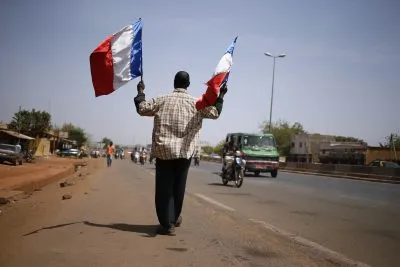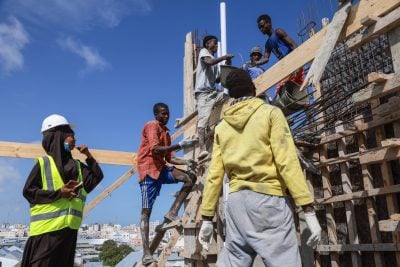The race is on to repair the massive Kariba Dam on the border between Zambia and Zimbabwe, as engineers warn that erosion threatens its great wall.
The Kariba Dam is one of Africa’s engineering wonders; 128m tall and 680m long, spanning the Zambezi River on the border between Zambia and Zimbabwe. Lake Kariba, the reservoir created by the dam, extends for 250km – 185bn tonnes of water held back by a thin strip of concrete.
Built in the 1950s to power Zambia’s copperbelt, the dam was considered a symbol of a brave new world in which the region’s nature was harnessed for rapid economic development. Today, it generates 1,626 MW of electricity for Zambia and Zimbabwe.
The great wall, however, is at risk. Spillway torrents have excavated a massive cavern in the riverbed by the wall, while a slow chemical reaction has swollen the concrete by the spillway gates, reducing their effectiveness in handling high water levels. Without $300m worth of urgent repairs, engineers say, the dam could fail within three years.
“Everything I have heard indicates that it is a serious problem and decisive action needs to be taken as soon as possible,” says international hydropower expert Bryan Leyland.
“If it was a nuclear power station in the same situation, it would be an international crisis.”
Should the wall collapse, the implications would be catastrophic. A recent World Bank study estimated that 3m people living on the 800km Zambezi River floodplain would be at risk. Economic damage to the region would exceed $8bn, with floodwaters washing away the Cahora Bassa Dam and destroying 40% of Southern Africa’s electricity capacity at a stroke.
African Business spoke to a number of engineers involved in the dam project, who were unanimous in their opinion that without quick action, Kariba will fail.
A race is now on to bring together a huge rehabilitation operation, which is further complicated by the politics of international financing structures.
The issues at Kariba were noticed at least six years ago, but the alarm was only raised publicly last year, as news filtered out into the tight-knit community on the banks of the lake. The World Bank’s report into the dam, The Kariba Dam Rehabilitation Project, was only made public in December.
PR disaster
Unsurprisingly, the revelation that the dam was in danger caused panic. The release of the information was chaotic as local politicians scrambled to reassure the public that the dam’s collapse was not imminent, while simultaneously trying to appraise the international community of the critical need for a solution.
The Zambezi River Authority has since conceded that the process was badly handled, but insists that the risk of a dam failure is being managed.
“Their problem was to convey to outside funding agencies the urgent need for major rehabilitation of the dam without causing unnecessary panic among those who would be directly affected by a major failure,” says the company’s communications manager, Elizabeth Karonga.
Acknowledging that there is “cause for grave concern,” Karonga insists that “the engineers on the ground have the situation under control.”
Some in the area think it was all a ploy to spur donors into action. “Some public announcements were about rattling the cages of international funders,” confided one Kariba businessman. “And it worked. It got their attention and after that money for repairs came quite quickly, all $300m.”
The European Investment Bank pledged $100m, World Bank and African Development Bank offered $75m each, while the Swedish government contributed a further $47m. Even this, however, did not come without complications.
While Zambia is entitled to financial assistance from the international donor community, Zimbabwe is not because of its non-accrual status with the Bretton Woods institutions. As the World Bank report into the dam notes, “The Government of Zimbabwe is currently limited in its access to concessional financing until settlement of outstanding arrears to the multilateral development banks.”
Repairing one side of the dam is not an option, but Zimbabwe would benefit from any work that was done.
The eventual solution was convoluted but workable. It involved making a loan of the funding package to the government of Zambia, a nation in better financial standing. The loan, which had a 38-year maturity, was then on-lent to the Zambezi River Authority, which is 50-50 owned by Zambia and Zimbabwe.
The ZRA is now obliged to repay the Zambian government through the water tariffs it charges to the power utilities in Zambia and Zimbabwe. The World Bank report justifies the financial arrangement with Zimbabwe by noting that “the Bank may provide a rapid response to a member country’s request for urgent assistance in respect of an event that has caused, or is likely to
imminently cause, a major adverse economic and/or social impact associated with natural or man-made crises or disasters.”
The prognosis
Engineers from both countries have drawn up a plan of action to tackle the threat. Perhaps counter-intuitively, they intend to excavate the plunge pool even further. The procedure should reduce the amount of turbulence in the cave.
“Think of it like sitting in your bath and splashing – you get water all over the floor and walls,” says Alan Bates, a hydroelectric scheme expert, who has worked extensively in Africa and visited Kariba several times.
“If you did the same in a large swimming pool you would dissipate the same energy but without all the damage.”
Fixing the floodgates will be a lengthier process, and could take up to eight years. If the work begins as soon as possible, the threat to Kariba should diminish. However, the process has been repeatedly delayed for reasons that have not been made public.
Kariba’s designers, Tractabel Engineering – formerly known as Coyne et Bellier – whose contract for monitoring and maintenance of the dam was renewed in 2010, did not respond to repeated requests for comment.
As the process to save the Kariba dam rumbles on, questions are being asked as to why the dam was allowed to deteriorate as badly as it did – and whether the $300m will be enough. Given the complexity of draining and rehabilitating the plunge pool, the answer, hydropower expert Leyland says, is “probably not.”
Want to continue reading? Subscribe today.
You've read all your free articles for this month! Subscribe now to enjoy full access to our content.
Digital Monthly
£8.00 / month
Receive full unlimited access to our articles, opinions, podcasts and more.
Digital Yearly
£70.00 / year
Our best value offer - save £26 and gain access to all of our digital content for an entire year!
 Sign in with Google
Sign in with Google 


